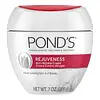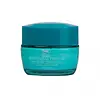What's inside
What's inside
 Key Ingredients
Key Ingredients

 Benefits
Benefits

 Concerns
Concerns

 Ingredients Side-by-side
Ingredients Side-by-side

Water
Skin ConditioningLactic Acid
BufferingGlycerin
HumectantButylene Glycol
HumectantCetyl Alcohol
EmollientIsopropyl Palmitate
EmollientSteareth-21
CleansingDimethicone
EmollientParaffinum Liquidum
EmollientEthylhexyl Methoxycinnamate
UV AbsorberSteareth-2
EmulsifyingPotassium Hydroxide
BufferingStearyl Dimethicone
EmollientStearic Acid
CleansingBorago Officinalis Seed Oil
EmollientMagnesium Aluminum Silicate
AbsorbentPhenoxyethanol
PreservativeHydroxyethyl Acrylate/Sodium Acryloyldimethyl Taurate Copolymer
Emulsion StabilisingParfum
MaskingOctadecene
SolventIsohexadecane
EmollientMethylparaben
PreservativeHydroxyethylcellulose
Emulsion StabilisingDimethiconol
EmollientXanthan Gum
EmulsifyingDisodium EDTA
Tocopheryl Acetate
AntioxidantPropylparaben
PreservativeBenzophenone-3
UV AbsorberPolysorbate 60
EmulsifyingPotassium Carbonate
BufferingSorbitan Isostearate
EmulsifyingSodium Nitrate
SoothingTocopherol
AntioxidantQuartz
AbrasiveAscorbyl Palmitate
AntioxidantDisodium Phosphate
BufferingBHT
AntioxidantPhospholipids
Skin ConditioningSodium Phosphate
BufferingHydrolyzed Collagen
EmollientCholesterol
EmollientCitronellol
PerfumingCitrus Aurantium Peel Oil
Coumarin
PerfumingGeraniol
PerfumingHexyl Cinnamal
PerfumingLimonene
PerfumingLinalool
PerfumingLinalyl Acetate
MaskingTerpineol
MaskingTetramethyl Acetyloctahydronaphthalenes
MaskingCI 77891
Cosmetic ColorantWater, Lactic Acid, Glycerin, Butylene Glycol, Cetyl Alcohol, Isopropyl Palmitate, Steareth-21, Dimethicone, Paraffinum Liquidum, Ethylhexyl Methoxycinnamate, Steareth-2, Potassium Hydroxide, Stearyl Dimethicone, Stearic Acid, Borago Officinalis Seed Oil, Magnesium Aluminum Silicate, Phenoxyethanol, Hydroxyethyl Acrylate/Sodium Acryloyldimethyl Taurate Copolymer, Parfum, Octadecene, Isohexadecane, Methylparaben, Hydroxyethylcellulose, Dimethiconol, Xanthan Gum, Disodium EDTA, Tocopheryl Acetate, Propylparaben, Benzophenone-3, Polysorbate 60, Potassium Carbonate, Sorbitan Isostearate, Sodium Nitrate, Tocopherol, Quartz, Ascorbyl Palmitate, Disodium Phosphate, BHT, Phospholipids, Sodium Phosphate, Hydrolyzed Collagen, Cholesterol, Citronellol, Citrus Aurantium Peel Oil, Coumarin, Geraniol, Hexyl Cinnamal, Limonene, Linalool, Linalyl Acetate, Terpineol, Tetramethyl Acetyloctahydronaphthalenes, CI 77891
Water
Skin ConditioningSodium Hyaluronate
HumectantGlycerin
HumectantIsopropyl Palmitate
EmollientButyrospermum Parkii Butter
Skin ConditioningPanthenol
Skin ConditioningButylene Glycol
HumectantGlyceryl Stearate
EmollientHydrogenated C12-18 Triglycerides
EmollientCocoglycerides
EmollientOctyldodecanol
EmollientSodium Citrate
BufferingStearyl Alcohol
EmollientCetyl Alcohol
EmollientGlycine Soja Germ Extract
EmollientTocopherol
AntioxidantMethyl Methacrylate Crosspolymer
Acrylates/C10-30 Alkyl Acrylate Crosspolymer
Emulsion StabilisingWater, Sodium Hyaluronate, Glycerin, Isopropyl Palmitate, Butyrospermum Parkii Butter, Panthenol, Butylene Glycol, Glyceryl Stearate, Hydrogenated C12-18 Triglycerides, Cocoglycerides, Octyldodecanol, Sodium Citrate, Stearyl Alcohol, Cetyl Alcohol, Glycine Soja Germ Extract, Tocopherol, Methyl Methacrylate Crosspolymer, Acrylates/C10-30 Alkyl Acrylate Crosspolymer
 Reviews
Reviews

Ingredients Explained
These ingredients are found in both products.
Ingredients higher up in an ingredient list are typically present in a larger amount.
Butylene Glycol (or BG) is used within cosmetic products for a few different reasons:
Overall, Butylene Glycol is a safe and well-rounded ingredient that works well with other ingredients.
Though this ingredient works well with most skin types, some people with sensitive skin may experience a reaction such as allergic rashes, closed comedones, or itchiness.
Learn more about Butylene GlycolCetyl Alcohol is a fatty alcohol. Fatty Alcohols are most often used as an emollient or to thicken a product.
Its main roles are:
Though it has "alcohol" in the name, it is not related to denatured alcohol or ethyl alcohol.
The FDA allows products labeled "alcohol-free" to have fatty alcohols.
Learn more about Cetyl AlcoholGlycerin is already naturally found in your skin. It helps moisturize and protect your skin.
A study from 2016 found glycerin to be more effective as a humectant than AHAs and hyaluronic acid.
As a humectant, it helps the skin stay hydrated by pulling moisture to your skin. The low molecular weight of glycerin allows it to pull moisture into the deeper layers of your skin.
Hydrated skin improves your skin barrier; Your skin barrier helps protect against irritants and bacteria.
Glycerin has also been found to have antimicrobial and antiviral properties. Due to these properties, glycerin is often used in wound and burn treatments.
In cosmetics, glycerin is usually derived from plants such as soybean or palm. However, it can also be sourced from animals, such as tallow or animal fat.
This ingredient is organic, colorless, odorless, and non-toxic.
Glycerin is the name for this ingredient in American English. British English uses Glycerol/Glycerine.
Learn more about GlycerinIsopropyl Palmitate is a texture enhancer and emollient. It is an ester of isopropyl alcohol and palmitic acid.
Palmitates are emollients. Emollients help keep your skin soft and smooth by creating a barrier that traps moisture in.
When added to cosmetics, Isopropyl Palmitate creates a silky texture and improves spreadability.
Isopropyl Palmitate may not be fungal acne safe. It can worsen acne prone skin.
Learn more about Isopropyl PalmitateTocopherol (also known as Vitamin E) is a common antioxidant used to help protect the skin from free-radicals and strengthen the skin barrier. It's also fat soluble - this means our skin is great at absorbing it.
Vitamin E also helps keep your natural skin lipids healthy. Your lipid skin barrier naturally consists of lipids, ceramides, and fatty acids. Vitamin E offers extra protection for your skin’s lipid barrier, keeping your skin healthy and nourished.
Another benefit is a bit of UV protection. Vitamin E helps reduce the damage caused by UVB rays. (It should not replace your sunscreen). Combining it with Vitamin C can decrease sunburned cells and hyperpigmentation after UV exposure.
You might have noticed Vitamin E + C often paired together. This is because it is great at stabilizing Vitamin C. Using the two together helps increase the effectiveness of both ingredients.
There are often claims that Vitamin E can reduce/prevent scarring, but these claims haven't been confirmed by scientific research.
Learn more about TocopherolWater. It's the most common cosmetic ingredient of all. You'll usually see it at the top of ingredient lists, meaning that it makes up the largest part of the product.
So why is it so popular? Water most often acts as a solvent - this means that it helps dissolve other ingredients into the formulation.
You'll also recognize water as that liquid we all need to stay alive. If you see this, drink a glass of water. Stay hydrated!
Learn more about Water